1962: The United States fires up the first — and only — nuclear reactor in Antarctica.
While the idea of placing a nuclear plant in such an ecologically sensitive location may seem like madness today, in the pre-Chernobyl, pre–Three Mile Island world of 1962, nuclear power was seen as a cost-effective, efficient and relatively safe way of providing power to permanent Antarctic research stations.
Supplying those stations posed a real logistical problem. By the '60s some stations were manned on a year-round basis and the burden of shipping millions of gallons of diesel fuel to the south was both arduous and expensive. When the additional expense of heating the stored fuel (to prevent solidification) was factored in, costs ran anywhere from $1 to $3 per gallon (equivalent to $7 to $21 in today's money), according to a U.S. Navy study at the time.
While there were logistical reasons for building the plant, there were political ones as well: President Eisenhower's full-court press to sell the idea of nuclear energy to the American public, through a program known as Atoms for Peace, was in full swing by the mid-1950s, when the planning for an Antarctic reactor began.
The reactor, designated PM-3A, was a portable plant designed and built by the Martin Company (a forerunner of Lockheed-Martin). It was intended not only to provide electrical power but to run a water-distillation plant as well. Martin Company designed PM-3A to fit inside a C-130 transport plane, although in the end it was sent to Antarctica by ship.
The reactor was set up at McMurdo Station, on a barren spit of land selected by the United States in 1955 for its largest Antarctic research station.
There were problems with the plant from the beginning. It underperformed to expectations and frequently fell victim to power failures. It also raised concerns in New Zealand, where U.S. Navy ships transporting the fuel and waste under Operation Deep Freeze would dock for a few days while in transit. All of these factors led to PM-3A existing on very shaky ground almost from the day it began operating.
The coup de grace, however, came in 1972 when a leak in the reactor's pressure vessel was discovered during a routine inspection. A closer look uncovered cracks throughout the reactor, caused by failures in some of the welds, and the decision was made to close and dismantle PM-3A.
Disposal presented other headaches. Decommissioned nuclear plants are usually entombed in concrete, but provisions in the Antarctic Treaty made this impossible, so the dismantled plant, along with some of the contaminated ground surrounding it, was bundled aboard the USS Towle for shipment to a disposal site in California.
McMurdo returned to diesel power.

